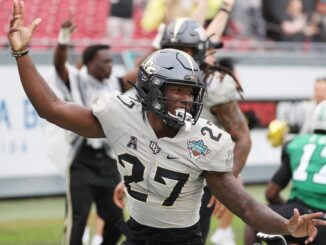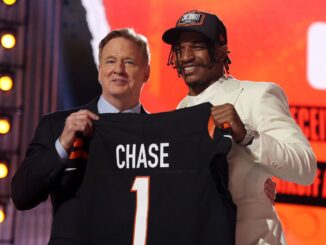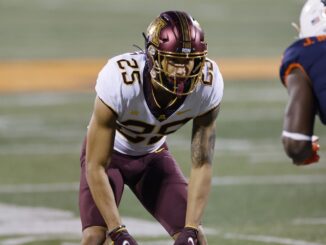This year’s linebacker class is an interesting one and it is characterised by its variety. If you want a run-stuffer, you need look no further than Nick Bolton and Cameron McGrone. If you want coverage ability, there is Owusu-Koramoah and Jabril Cox. Then there are the likes of Micah Parsons and Zaven Collins, who will be excellent in blitz-heavy defenses. Here are my top ten linebackers in the 2021 NFL Draft.
2021 Position Rankings
QB | RB | WR | TE | OT | IOL | IDL | EDGE | CB | S
1. Micah Parsons – Penn State

Pros: Parsons is incredibly athletic and has all of the physical tools you want in a linebacker prospect. At his pro day he ran a 4.36 40-yard dash and posted a 10’6″ broad jump. His instincts are excellent, particularly against the run, and he does a nice job of navigating traffic to make plays on the ball carrier. He is one of the best tacklers in this year’s class, with just 11 misses on 188 career attempts. Parsons was a five-star defensive end prospect and it shows on tape. He is able to win one-on-ones with offensive linemen and is a nightmare as a blitzer. Parsons posted 36 pressures and eight sacks on just 135 career pass rushing snaps. He was voted as an All-American in both of his seasons at Penn State.
Cons: The biggest concern with Parsons will be his issues off the field. He was named as a ringleader in the Penn State hazing scandal and there have been numerous reports of immaturity stretching back to his time in high school. On the field, Parsons lacks the coverage ability you want in a linebacker. He had just four pass breakups on his 68 targets and played in a spot-drop heavy scheme at Penn State. He was rarely tested in man coverage as a result, and how he will deal with more diverse coverage responsibilities remains something of an unknown.
Projection: 1st round (top ten)
2. Jeremiah Owusu-Koramoah – Notre Dame

Pros: Owusu-Koramoah is the best coverage linebacker in the 2021 class. He has all of the athletic ability you could want at the position and could plausibly transition to a full-time safety role in the NFL. He is a smooth mover in coverage, with fluid hips and the ability to turn and run with receivers. Notre Dame often asked him to move out to the slot in man coverage and he proved capable of sticking with shiftier slot receivers. Owusu-Koramoah is really explosive and has excellent short area burst. Despite not being the biggest linebacker he was an effective blitzer in college and made his presence known in the backfield. He is a hard hitter and was responsible for six forced fumbles during his time in South Bend.
Cons: At just 6’1″ and 221 lbs, Owusu-Koramoah is small for a linebacker and could struggle to transition to the more physical aspects of the NFL game. He played the ‘overhang’ role in the Notre Dame defense which doesn’t really translate to a traditional inside linebacker role at the next level. He can also sometimes be a little bit over-eager to make plays which leads to him taking poor pursuit angles and overrunning the ball carrier. Owusu-Koramoah isn’t a bad tackler, but he could certainly be more reliable and can struggle to wrap up in space.
Projection: 1st round
3. Nick Bolton – Missouri

Pros: Bolton’s instincts and processing speed makes him one of the best linebackers in this year’s class. He isn’t the biggest player, but he is a hard hitter who loves getting downhill and making plays. He excels in run defense, with the lateral agility to shut down plays anywhere on the field. His 77 run stops since 2019 are the second most by any Power Five linebacker. He is also surprisingly effective in coverage given his average athletic profile. Bolton led all FBS linebackers with a 90.2 PFF coverage grade in 2019 and has accounted for 13 forced incompletions over the last two seasons.
Cons: When it comes to measurables, Bolton doesn’t stand up well when compared to his fellow classmates. At just 5’11” and 237 lbs he is on the small end of what you want in a linebacker. He can often get stuck on blocks as a result and his lack of length can cause issues when tackling. He also lacks the elite athleticism of players like Parsons and Owusu-Koramoah and his change of direction ability isn’t great. As a result there will be concerns about whether or not he will be able to translate his success in coverage to the next level.
Projection: 2nd round
4. Zaven Collins – Tulsa

Pros: Collins is a big and powerful edge who at 6’5″ and 259 lbs looks more like an edge rusher. Unsurprisingly he is a fantastic blitzer, with the length and short area quickness to cause a tonne of problems for opposing linemen. In 2020 he racked up 16 pressures and four sacks on just 51 pass rushing snaps. He pairs this with good athleticism and movement skills for the position. Collins has also shown himself to be comfortable in coverage and has 14 forced incompletions on just 65 career targets. He even had two pick sixes in 2020. His career passer rating allowed on 60.0 is the lowest of any linebacker on this list.
Cons: Despite possessing great length and size, Collins isn’t the most dominant tackler. He has a 14.6 per cent missed tackle rate across his college career and this isn’t helped by his poor technique. He also has a tendency to get drawn in by play fakes and misdirection. Collins is one of the most scheme-specific players in this year’s class and will only really fit in a blitz-heavy scheme that allows its linebackers to get after the quarterback. There will also be questions about the level of competition he faced at Tulsa and he had just four career starts against Power Five opponents.
Projection: 2nd round
5. Jabril Cox – LSU

Pros: Cox is an incredible athlete and could rival Owusu-Koramoah as the best coverage linebacker in this year’s class. He is a really smooth mover who is capable of turning and running with slot receivers and tight ends. LSU lined him up as a slot corner on more than a quarter of his snaps in 2020 and he showed he is comfortable is press coverage, a rare trait in a linebacker. His coverage instincts are thoroughly impressive and he has a great feel for playing in zone. His ball production is another major strong point, with 19 career forced incompletions. Cox excelled in two different defensive schemes, beginning his career at North Dakota State, before transferring to LSU in 2020.
Cons: Cox’s ability as a run defender doesn’t match his coverage prowess. He can be slow to process against the run and his gap discipline is inconsistent. He isn’t the hard hitter that some teams will want at the position and he can struggle to free himself when engaged with a blocker at the second level. His play strength generally is an issue and he lacks the lower body strength to be a consistent presence against the run. This also impacts his ability as a tackler. Whilst he did miss a tonne, he sometimes struggles to bring runners down in space.
Projection: 2nd round
6. Jamin Davis – Kentucky

Pros: Davis has the combination of size and speed that will intrigue defensive coordinators. His 79.8″ wingspan gives him a huge tackle radius and he rarely misses. Davis logged just 11 misses on 150 career attempts, the second best rate of anyone on this list. He was excellent against the run, with his 87.5 PFF run defense grade being the highest of any draft-eligible linebacker in 2020. Davis is a freaky athlete too, running a 4.47 40-yard dash at his pro day and setting a positional record with his 42″ vertical jump. He also had some impressive reps in coverage last season, posting three interceptions and allowing a passer rating of just 66.6.
Cons: Davis was only a one-year starter at Kentucky, which is pretty surprising when you consider the lack of talent ahead of him at the position. As a result, his sample size is seriously limited and he has just 837 career snaps to his name. Whilst he has the tools to be effective in coverage, he played a simplistic spot-drop role at Kentucky and was rarely tested in man coverage. Whilst he has good height and length, Davis is a little lean and lacks ideal power on contact. He can also play a little upright and needs to do a better job of staying low when tackling.
Projection: 2nd round
7. Baron Browning – Ohio State

Pros: Browning ticks the boxes as far as size and athleticism are concerned. His 9.98 Relative Athletic Score is the highest at the position in this year’s class and the fifth highest by any linebacker since 1987. He is a hard hitting tackler who excels when coming downhill. With 33.5″ arms he has ideal length and is adept at shedding blocks to make plays on the ball carrier. His change of direction ability is impressive and he has the loose hips you want at the position. Browning’s short area quickness is impressive and he has the tools to be a legitimate pass rushing threat off the edge. He racked up 35 pressures and eight sacks on just 141 pass rushing snaps.
Cons: Browning’s biggest weakness is his play recognition and instincts. He has all of the physical tools you could want at the position, but he doesn’t show the anticipatory skills you need in a linebacker. He has issues when reading against the run and can often be sucked in by misdirection and play action. His instincts are lacking in coverage too and he has just three career pass breakups. Browning’s 123.9 passer rating when targeted is the second worst rate on this list. His tackling improved in 2020, but it has been pretty inconsistent throughout his time at Ohio State.
Projection: 3rd round
8. Cameron McGrone – Michigan

Pros: McGrone is an excellent athlete with the sideline-to-sideline agility you want at the position. He is particularly impressive as a run defender and reads that aspect of the game very well. He does a great job of moving laterally and shutting down runs to the outside, taking good pursuit angles. McGrone is adept at navigating traffic and working through contact to make plays on the ball carrier. He is one of the best tacklers in this class, with great form. He logged just nine misses on 96 career attempts and did not miss a single tackle in 2020, despite playing with a cast on his left hand. McGrone is a powerful linebacker who plays with a noticeably high motor.
Cons: McGrone’s biggest weakness is easily his ability in coverage. At this point he has absolutely no feel for that aspect of the game and this will be even more of an issue in the NFL. Michigan used him in a mixture of man and zone roles and he looked lost in both. He also lacks the height and length you want at the position, standing at just 6’0″ with 32.1″ arms. McGrone didn’t play a tonne at Michigan and has just 943 career snaps to his name. He saw a notable dip in form in 2020, although this was likely the result of playing through injuries.
Projection: 3rd round
9. Chazz Surratt – North Carolina

Pros: Surratt has excellent short area quickness and burst and he flies around the field. Few can rival his high motor and explosiveness and he was a notable presence on UNC’s defense in his two years as a starter. He is athletic enough to kick out and cover tight ends in the slot and also played some of his snaps as a pass rusher of the edge. Surratt is a former quarterback who only started playing linebacker in 2019 and has since won First Team All-ACC honours twice. He production as a blitzer was seriously impressive too. Surratt finished his career with 62 pressures and 13 sacks on just 200 career pass rushing snaps.
Cons: The biggest concern with Surratt will be his lack of length. He measured in with just 30.1″ arms, which ranks in the 2nd percentile at the position. This inhibits his ability to get off blocks and tackle consistently in the open field. Whilst Surratt has been impressive in his short time at the position, he is still learning the nuances of the position. He can be fooled by misdirection and he is inconsistent in his run fits. His athletic ability allowed him to make up for some slow processing in college, but that won’t work in the NFL.
Projection: 4th round
10. Pete Werner – Ohio State

Pros: Werner is a physical and hard hitting linebacker. He offers good lateral agility and proved to be a solid run defender during his time at Ohio State. He has ideal length for the position and this allows him to work off blocks and make plays in traffic. Werner is also a good athlete, with smooth hips and change of direction ability. He has the fluid movement skills and quickness to be comfortable manning up against tight ends in the slot. His instincts and play recognition skills are solid too.
Cons: Werner doesn’t offer much in the passing game and is still fairly limited in terms of coverage. Whilst he has all of the necessary athletic tools, the coverage instincts aren’t there yet. Despite his physical playstyle, Werner was a surprisingly inconsistent tackler at Ohio State and had a career missed tackle rate of 15 per cent. Werner has been a solid starter for three years but doesn’t have any particular standout trait. At this point he is a ‘jack of all trades, master of none’ kind of player.
Projection: 4th round


